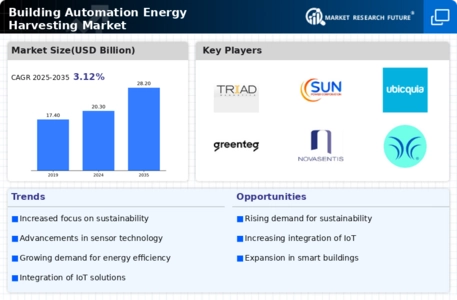Rising Energy Costs
The increasing cost of energy is a primary driver for the Building Automation Energy Harvesting Market. As energy prices continue to rise, building owners and managers are compelled to seek innovative solutions to reduce operational expenses. Energy harvesting technologies, which capture and utilize ambient energy sources, offer a viable alternative to traditional energy consumption methods. This shift not only enhances energy efficiency but also contributes to long-term cost savings. According to recent data, energy costs have surged by approximately 20% over the past five years, prompting a greater emphasis on energy-efficient solutions. Consequently, the Building Automation Energy Harvesting Market is likely to experience substantial growth as stakeholders prioritize cost-effective energy management strategies.
Government Regulations and Incentives
Government regulations and incentives are increasingly shaping the landscape of the Building Automation Energy Harvesting Market. Many governments are implementing policies aimed at promoting energy efficiency and reducing greenhouse gas emissions. These regulations often include financial incentives, such as tax credits and grants, for adopting energy-efficient technologies. As a result, building owners are more inclined to invest in energy harvesting solutions that comply with these regulations. Recent data suggests that regions with stringent energy efficiency mandates have seen a 30% increase in the adoption of energy harvesting technologies. This trend indicates that regulatory frameworks are likely to continue driving growth in the Building Automation Energy Harvesting Market.
Increased Awareness of Sustainability
The growing awareness of sustainability and environmental impact is a significant driver for the Building Automation Energy Harvesting Market. As organizations and individuals become more conscious of their carbon footprints, there is a heightened demand for sustainable building practices. Energy harvesting technologies align with these sustainability goals by reducing reliance on non-renewable energy sources and minimizing waste. Recent surveys indicate that over 70% of consumers prefer to engage with companies that prioritize sustainability. This shift in consumer behavior is likely to influence building design and management practices, further propelling the Building Automation Energy Harvesting Market as stakeholders seek to implement eco-friendly solutions.
Integration of Smart Building Solutions
The integration of smart building solutions is a pivotal driver for the Building Automation Energy Harvesting Market. As the demand for intelligent building systems rises, energy harvesting technologies are increasingly being incorporated into these frameworks. Smart buildings utilize advanced sensors and automation systems to optimize energy usage, and energy harvesting plays a critical role in powering these devices sustainably. The market for smart building technologies is projected to reach USD 100 billion by 2026, highlighting the potential for energy harvesting solutions within this sector. This integration not only enhances operational efficiency but also supports the overall growth of the Building Automation Energy Harvesting Market.
Advancements in Energy Harvesting Technologies
Technological advancements play a crucial role in propelling the Building Automation Energy Harvesting Market forward. Innovations in energy harvesting technologies, such as piezoelectric systems, thermoelectric generators, and solar energy solutions, have significantly improved efficiency and reliability. These advancements enable buildings to harness energy from various sources, including vibrations, temperature differentials, and sunlight. As a result, the market is witnessing a surge in the adoption of these technologies, with projections indicating a compound annual growth rate of over 15% in the coming years. This trend suggests that the Building Automation Energy Harvesting Market is poised for robust expansion, driven by the continuous evolution of energy harvesting solutions.


















Leave a Comment